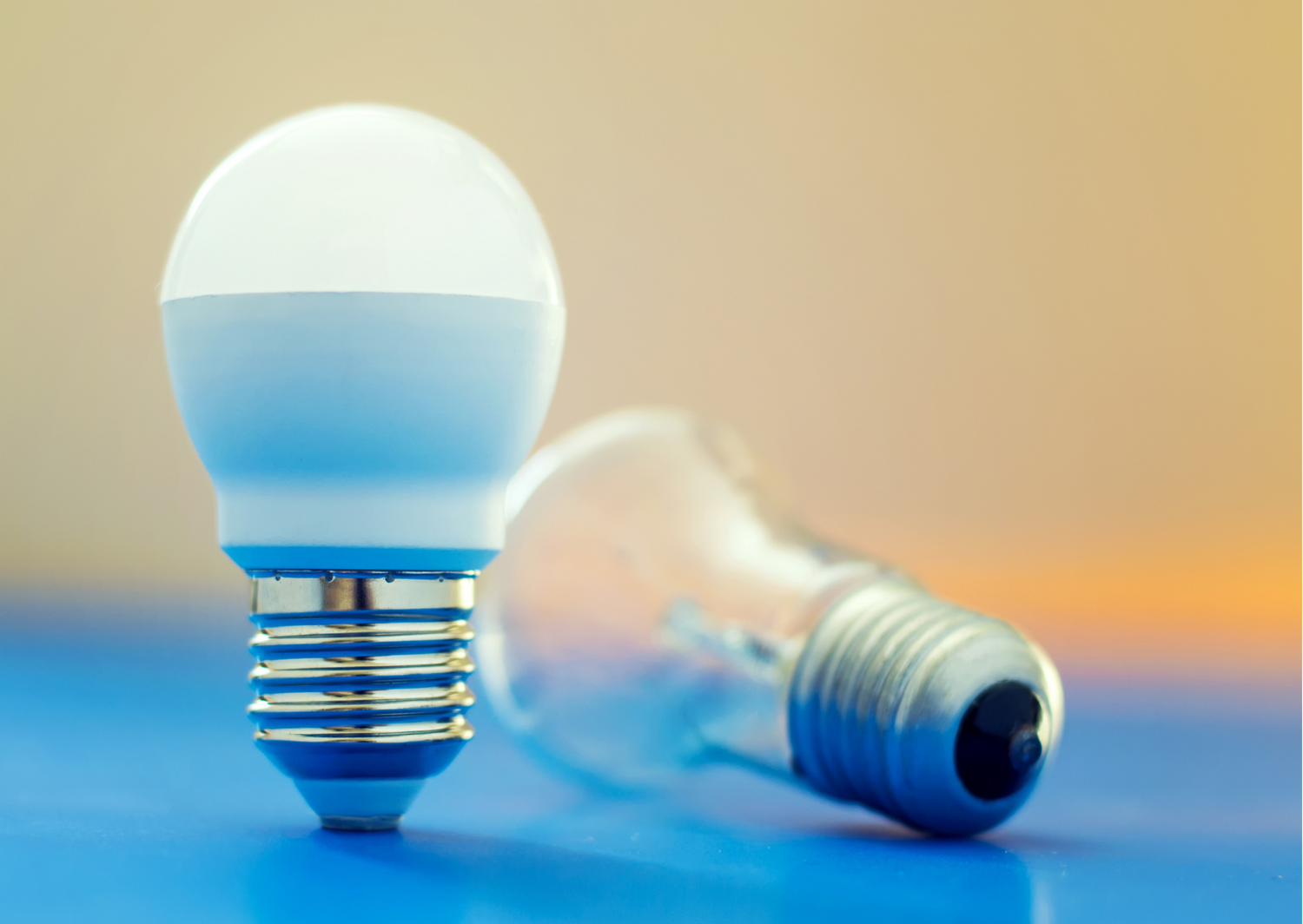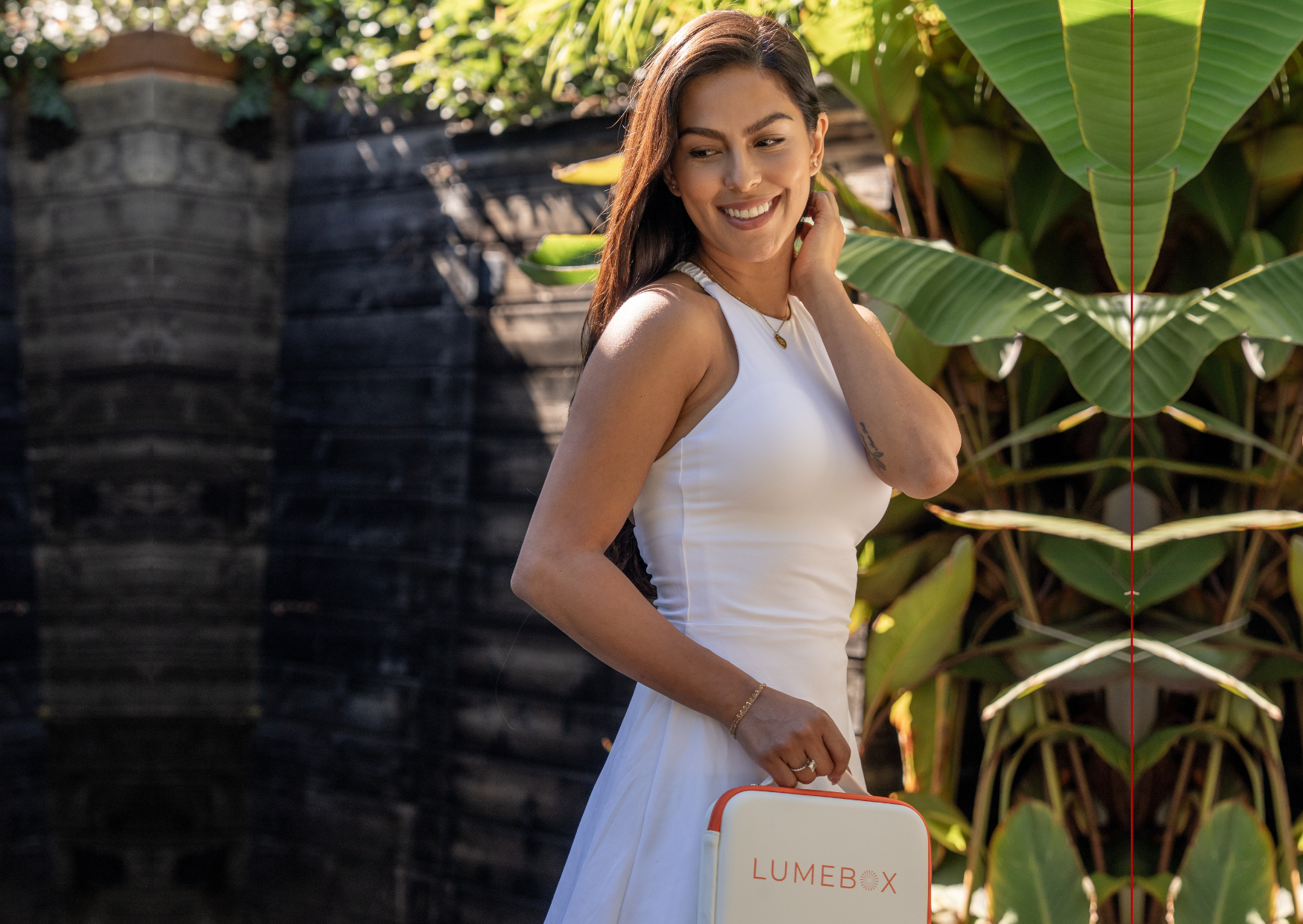LED lighting has stirred up some drama online lately, so let’s set the record straight: the LEDs people are worried about—messing with your sleep or causing eye strain—are the ones in home lighting, not the therapeutic LEDs in a LUMEBOX.
Think of it like a pair of shoes—flip-flops aren’t for hiking, and running shoes aren’t for a formal wedding. While they’re all called 'shoes,' they’re built for very different purposes. LEDs are the same. The ones used for home illumination are meant to light up a room broadly, while the LEDs in LUMEBOX devices are fine-tuned for wellness benefits.
Household LEDs: Designed for Brightness, Not Wellness
Household LEDs, the kind you find in light bulbs, ceiling fixtures, and screens (OLED) emit very different wavelengths and therefore serve a very different purpose than those used in red light therapy devices. These LEDs are:
1. Bright and Blue Light-Intensive:
LEDs for lighting often emit high levels of blue light (~470 nm). While we want a bit of blue light from the sun to help regulate our circadian rhythm during the day, exposure to it at night can suppress melatonin [1,2]—the hormone that helps you sleep—and shift your internal clock. Even brief exposures can have a significant impact on our sleep.
2. Prone to Flicker:
Many household LEDs run on alternating current (AC), causing them to flicker imperceptibly. For some people, this flicker contributes to headaches, eye strain, and fatigue.
3. Diffuse by Design (Wide Beam Angle):
Household LEDs are made to spread light across a large area for general illumination. Even if they emitted red light, these bulbs wouldn’t concentrate enough energy on a specific spot to provide therapeutic benefits because the light scatters everywhere.
LUMEBOX LEDs: Precision-Designed for Wellness
LUMEBOX LEDs are purpose-built for healthy benefits, delivering wavelengths in the RED and near-infrared (NIR) range in a focused and targeted way.
Here’s how they differ:
1. No Blue Light, Only Red, and NIR Wavelengths:
LUMEBOX LEDs emit red light at 660 nm and NIR light at 850 nm—wavelengths backed by science to support cellular energy, reduce inflammation, and promote recovery. They don’t emit any blue light, eliminating concerns about melatonin suppression or skin aging (prolonged exposure to high-intensity blue light may contribute to oxidative stress [3], which may result in skin aging [4], inflammation, and damage over time).
Studies have shown that red light exposure, especially at low brightness levels, has a much smaller impact on sleep compared to bright white or blue light. For example:
- In one study, participants exposed to bright white light (~4000 lux) in the evening experienced a 3-hour circadian phase delay, while dim red light (50 lux) caused only an 8-minute delay. [5]
- Additionally, this study [6] showed that red light therapy may help promote relaxation and improve sleep quality for some users. That’s why many customers prefer using LUMEBOX on the back of the neck before bed, rather than on the face (where the eyes are more exposed), to encourage a restful night.
2. Low Flicker:
As a battery-powered device running on direct current (DC), LUMEBOX has minimal flicker compared to household LEDs. Plus, we’ve included goggles to keep your eyes comfortable and protected during every session.
3. Focused Light Energy (Narrow Beam Angle):
LUMEBOX has a narrow beam angle, directing all its light energy into a small area. This concentrated focus delivers enough energy to penetrate deeper into the skin and tissues, unlike household LEDs designed to spread light broadly.
4. High Irradiance:
Irradiance refers to the intensity of light energy hitting a specific area. LUMEBOX delivers high irradiance (125-140 mW/cm²), ensuring enough power per square centimeter to support health benefits such as skin rejuvenation, joint care, inflammation reduction, and muscle recovery.
To put it into perspective, a typical red light bulb might have an irradiance of around 1-5 mW/cm²—far below the intensity of LUMEBOX. Even if household LEDs emit red light, they can’t match the strength required for the light to penetrate the skin, reach deeper tissues and joints, and activate our real energy centers—the mitochondria.
Tips for Reducing Blue Light Exposure
If you’re concerned about blue light from household LEDs, here are some tips to minimize its impact:
- Soak up natural daylight first thing in the morning and during the day to keep your circadian rhythm aligned. [7]
- Limit blue light exposure 2 hours before bed by dimming household lights, enabling night mode on devices, or wearing blue light-blocking glasses.
- Avoid bright lights if you wake up during the night. Use red or amber nightlights instead (e.g. use LUMEBOX as a night light!)
- Try red light therapy 1–2 hours before bed to relax. For example, using LUMEBOX on the back of your neck or upper back while meditating for 10 minutes can be a great way to wind down.
The Bottom Line: Are LEDs Safe?
TL;DR: Household LEDs and LUMEBOX LEDs serve completely different purposes.
LEDs might’ve been getting a bad rap on your Explore feed, but the reality is far less alarming.
Household LEDs can disrupt sleep and strain your eyes due to their blue light emission and flicker.
These LEDs are not inherently “bad” for you, but it’s helpful to keep the information above in mind when considering your light exposure throughout the day. You’re really only going to notice the effects of household and screen LEDs if you're exposed to them for extended periods—typically around 1-2 hours or more. [8]
When scrolling on your phone or laptop, try this: for every 10 minutes of screen time, spend at least 30 seconds looking as far into the distance as possible. It’s an easy way to give your eyes a break and reduce strain!
LUMEBOX LEDs avoid these pitfalls by focusing solely on red and NIR light, with minimal flicker and short, targeted treatment sessions (just 12 minutes).
There is something called the Biphasic Dose Response suggesting that an optimal dose of red light therapy can offer numerous benefits, but we don’t want to overdo it or these benefits will plateau.
New to red light therapy? Download our free eBook to help you choose the best device.
Already have a LUMEBOX? Download our 6 time-saving tricks guide!
Medical Disclaimer: The information contained in this blog post is intended for educational purposes only and should not be used as medical advice. Everyone responds to light differently. Testimonials are not a guarantee of the results you or anyone who uses LUMEBOX will get because your success depends entirely on your circumstances, and the studies on red light therapy shared were not specifically performed using LUMEBOX. Please check with your doctor before using red light therapy and do not change your medical treatments or lifestyle without consulting your physician first.
References:
[1] Nagai, N., Ayaki, M., Yanagawa, T., Hattori, A., Negishi, K., Mori, T., Nakamura, T. J., & Tsubota, K. (2019). Suppression of Blue Light at Night Ameliorates Metabolic Abnormalities by Controlling Circadian Rhythms. Investigative ophthalmology & visual science, 60(12), 3786–3793. https://doi.org/10.1167/iovs.19-27195
[2] Czeisler, C. A., Allan, J. S., Strogatz, S. H., Ronda, J. M., Sánchez, R., Ríos, C. D., Freitag, W. O., Richardson, G. S., & Kronauer, R. E. (1986). Bright light resets the human circadian pacemaker independent of the timing of the sleep-wake cycle. Science (New York, N.Y.), 233(4764), 667–671. https://doi.org/10.1126/science.3726555
[3] Vandersee S, Beyer M, Lademann J, Darvin ME. Blue-violet light irradiation dose dependently decreases carotenoids in human skin, which indicates the generation of free radicals. Oxid Med Cell Longev. 2015;2015:579675. doi: 10.1155/2015/579675. Epub 2015 Feb 9. PMID: 25741404; PMCID: PMC4337113.
[4] Kumari J, Das K, Babaei M, Rokni GR, Goldust M. The impact of blue light and digital screens on the skin. J Cosmet Dermatol. 2023 Apr;22(4):1185-1190. doi: 10.1111/jocd.15576. Epub 2023 Jan 3. PMID: 36594795.
[5] Campbell, S. S., Dawson, D., & Anderson, M. W. (1993). Alleviation of sleep maintenance insomnia with timed exposure to bright light. Journal of the American Geriatrics Society, 41(8), 829–836. https://doi.org/10.1111/j.1532-5415.1993.tb06179.
[6] Zhao J, Tian Y, Nie J, Xu J, Liu D. Red light and the sleep quality and endurance performance of Chinese female basketball players. J Athl Train. 2012 Nov-Dec;47(6):673-8. doi: 10.4085/1062-6050-47.6.08. PMID: 23182016; PMCID: PMC3499892.
[7] Blume, C., Garbazza, C., & Spitschan, M. (2019). Effects of light on human circadian rhythms, sleep and mood. Somnologie : Schlafforschung und Schlafmedizin = Somnology : sleep research and sleep medicine, 23(3), 147–156. https://doi.org/10.1007/s11818-019-00215-x
[8] Kaur K, Gurnani B, Nayak S, Deori N, Kaur S, Jethani J, Singh D, Agarkar S, Hussaindeen JR, Sukhija J, Mishra D. Digital Eye Strain- A Comprehensive Review. Ophthalmol Ther. 2022 Oct;11(5):1655-1680. doi: 10.1007/s40123-022-00540-9. Epub 2022 Jul 9. PMID: 35809192; PMCID: PMC9434525.





